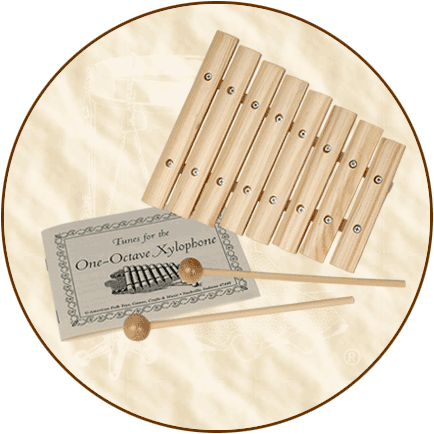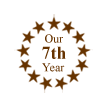.
Continued from product description on
Folk Instruments' Page Four...
Historical
Background: The xylophone is a percussion musical instrument
that has a series of graduated wooden bars, which are mounted
on a frame. These bars are loosely mounted on the frame at their
ends (or nods). In addition to the bars, a gourd or tubular resonator
may also be suspended under each bar. Some xylophones use the
frame as the resonator and have a cupped trough mounted on the
underside of the frame. A xylophone player (called a "xylophonist")
holds mallets which he uses to strike the bars. The bars are
made from either hardwoods or bamboo.
There are many sizes of xylophones. Some have a single row
of bars while others may have two rows, such as an orchestral
xylophone. The bars of an orchestral xylophone are arranged like
piano keys and have tubular resonators that are tuned to each
bar. The range of this instrument is usually four octaves, beginning
with the middle C note. Another type of orchestral xylophone
is the marimba. This instrument is pitched an octave lower than
the xylophone.
Sound is produced by striking the bars with mallets. Two hard
mallets can be used to make a dry, penetrating sound; or, multiple
pairs of soft, rubber mallets can be used for a soft passage
or muted chords.
The name "xylophone" comes from two Greek words:
"xylon" (which means "wood") and "phone"
(the Greek word for "sound").
Historians believe the xylophone first appeared in eastern
Asia or China. The earliest evidence we have are 9th-century
xylophones found in southeast Asia. A type of wood harmonicon
with 16 suspended bars is believed to have existed in China around
2000 B.C. A similar xylophone-type instrument called a "ranat"
probably existed in Hindu regions about the same time. Such instruments
are depicted in numerous temple reliefs from this region of present-day
India.
The simplest xylophone had just two bars that were laid across
the player's legs. Later, more complex xylophones were made using
many bars that were mounted on a frame. It is thought that the
xylophone was next introduced to the African continent, possibly
via the island now called Madagascar. Then again, it is possible
Africans invented the xylophone independently. After all, there
have been many musical instruments that were created simultaneously
in remote parts of the world.
Exactly when the xylophone was introduced (or invented) in
Africa is unknown. It is known that this musical instrument existed
in Africa before the 14th century. Historical records from the
mid-1400s mention xylophones in the Niger River region now called
Mali. In the 1600s, Portuguese missionaries reported seeing sophisticated
xylophones in Ethiopia. These xylophones had a resonator made
of calabash. Portuguese missionary Dos Santos reported seeing
a similar type of xylophone called an "ambira" in the
African region now known as Mozambique.
Regardless of origin, the xylophone was widely accepted by
Africans and became a prominent musical instrument in African
music. Although they are not common in every region, the highest
concentrations can be found along Africa's east and west coasts.
It is interesting to note that it was African slaves who introduced
the xylophone to Central America, where it evolved into the marimba
and became a characteristic part of Cuban music.
Today, the xylophone is considered a quintessential part of
African music because of its ability to produce sounds that express
this music's innate sense of rhythm. This important role is augmented
by the fact that there are so many types of xylophones. Regardless
of the many varieties, they all fall into one of two broad categories.
The first group consists of xylophones that have separate bars
which can be arranged in any order. The other group are xylophones
that have fixed bars which are tied together.
The simplest forms of the xylophone are the "leg xylophone"
and the "pit xylophone." Leg xylophones have an unspecified
number of bars that are laid on the legs of the player. The open
space under the player's legs acts as the resonator. The pit
xylophone, on the other hand, is made by placing the bars on
rolled-up banana leaves over an open pit. Thus, it is the open
pit that acts as the instrument's resonator.
One of the most important types of African xylophones is the
"log xylophone." This instrument has the bars laid
across two logs or "beams." These bars range in length
from 12 to 22 centimeters and have holes near the ends to allow
wooden pins on the beams to protrude through and keep the bars
in place. In Uganda, these xylophones are called "amadinda."
Larger versions were also called "akadinda." Akadindas
were used to play music for the courts of African kings.
Yet another type of African xylophone is the "gourd xylophone."
This complex instrument uses dried and hollowed-out gourds for
resonators. Each gourd is carefully selected because its pitch
must correspond exactly to the bar. African musicians have been
known to travel great distances to find gourds to suit their
needs. Today, bamboo canes, canisters and metal casings are substituted
for gourd resonators.
Gourd xylophones make use of a unique form of amplification
called "mirlitons." This type of amplification is achieved
by drilling a hole in each gourd which is then covered by a membrane.
Membranes were generally made with parts of spiders' nests until
paper was available. This paper-thin membrane vibrates in sympathy
when its corresponding bar is struck. The result is a range of
buzzing noises similar to those produced on European frame harps
used in the late Middle Ages.
The xylophone was introduced to eastern Europe in the 1500s.
It soon became a popular folk instrument in central Europe. It
is mentioned in the 1511 work "Spiegel der Orgelmacher und
Organisten" by Arnold Schlick, a German organist. Schlick
called the instrument "hültze glechter" (German
for "wooden laughter"), and this became the name for
the xylophone used by German-speaking people.
The xylophone is also mentioned by many influential theoreticians
during this period, such as Martin Agricola and Michael Praetorius
("Theatrum Instrumentorum"). The name "straw fiddle"
was also commonly used due to the European practice of placing
the bars on straw skeins. During the Middle Ages, xylophones
were relatively simple and did not have resonators. Straw fiddles
became popular with wandering minstrels and as virtuoso instruments
in circuses. Popularity for this instrument lasted for centuries
and into the 1900s.
The first known depiction of a xylophone in Europe is the
famous 1523 painting "Dance of Death" by Hans Holbein
the Younger. This painting shows a skeleton playing a portable
xylophone in a procession of death imagery. Since then, the xylophone
has been closely associated with the rattling of bones to many
Europeans.
In the Alpine region of Europe, xylophone bars were arranged
in four rows. The middle rows of bars were notes that corresponded
to the piano's white keys. And as one might deduce, the outside
rows had bars that represented the black keys. Interestingly,
these bars were not laid out lengthwise like African and Asian
xylophones. Instead, bars were laid crossways to the player,
with the longest bar closest to the xylophonist. The shortest
bar was the farthest away. As with other European xylophones,
this version did not have resonators. Players also used hammers
to strike the bars in the same manner as playing a dulcimer.
While this bar arrangement may seem unconventional, it did allow
one distinct advantage: note sequences that occurred frequently
(such as broken chords) could be played at an increased speed.
Polish and Russian performers introduced and popularized the
xylophone in western Europe during the early 1800s. However,
it would not be until the next century that the xylophone would
be seriously considered as an orchestral instrument. The earliest
known composition for the xylophone was written by Ignaz Schweigl
in 1803. In 1810, Ferdinand Kauer wrote "Sei Variazioni"
and included the xylophone in his arrangement.
Despite the increasing acceptance of the xylophone by European
composers, its orchestral debut did not occur until 1874. The
French composer Camille Saint-Saëns was one of the first
to compose prominent parts for the xylophone in his orchestral
works "La Danse Macabre" (1875) and "Le Carnaval
des Animaux" (1886). (By the way, the type of xylophone
used then was the four-row version.)
A tutor (instruction book) for the four-row xylophone was
written by Albert Roth and published in 1886. In his tutor, Roth
also introduced a two-row, chromatic arrangement of the bars
mimicking the piano key pattern. Roth's work guided the development
of today's orchestral xylophone and its two-row, chromatic bar
arrangement (with resonators).
In 1903, John Deagan became one of the first manufacturers
of orchestral xylophones. This American-made instrument soon
became the standard xylophone used by symphonic and theatrical
orchestras (as well as dance bands) around the world. Popularity
for the xylophone continued in the 20th century with the advent
of music records, which is attributed to how well the xylophone
sounded on early recordings.
Throughout the 1900s or "the century of percussion,"
the xylophone played an increasing role in orchestral compositions,
along with other percussion instruments. Some composers who placed
percussion instruments at the forefront of their arrangements
were Béla Bartók, Pierre Boulez, Olivier Messiaen,
Karheinz Stockhausen, Igor Stravinsky, and Edgard Varése.
Fun
Fact: Traveling virtuosos sparked the interests of composers
Felix Mendelssohn Bartholdy (1809-1847) and Frédéric
Chopin (1810-1849) in the xylophone.
Fun
Fact: The word "xylophone" was first recorded
in the April 7, 1866, edition of the "Athenaeum": "A
prodigy... who does wonderful things with little drumsticks on
a machine of wooden keys, called a 'xylophone'."
Fun
Fact: The G-E-C note combination was made famous in 1931
by the National Broadcasting Company (NBC) and was granted the
first audio trademark by the U.S. Patent and Trademark Office.
Even though chimes were used, many a child in the early days
of television tried to mimic this trademark on their toy xylophone.
Fun
Fact: Xylophones with metal bars are called "metallaphones."
Metallophones with tubular resonators that are rotated by a motor
are call "vibraphones."













